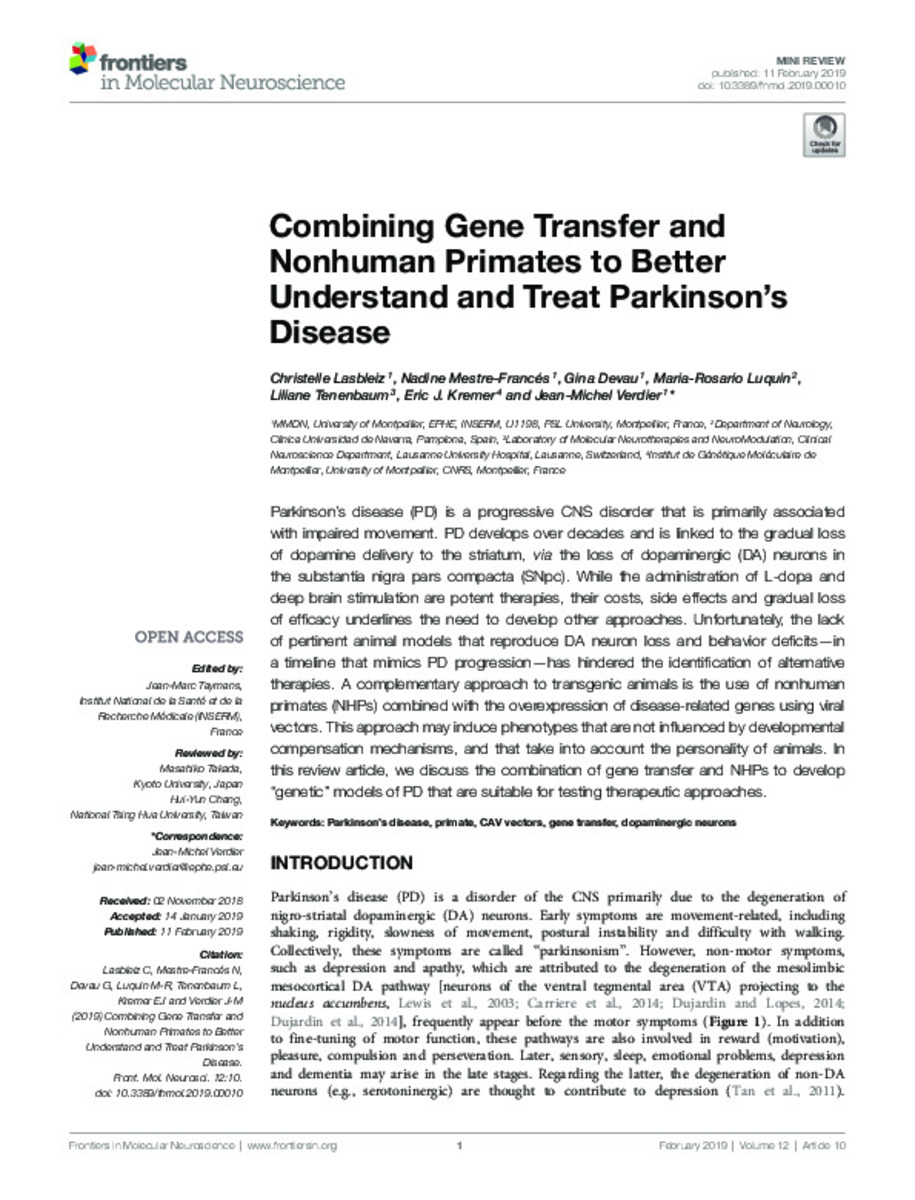Full metadata record
| DC Field | Value | Language |
|---|---|---|
| dc.creator | Lasbleiz, C. (Christelle) | - |
| dc.creator | Mestre-Francés, N. (Nadine) | - |
| dc.creator | Devau, G. (Gina) | - |
| dc.creator | Luquin, M.R. (María Rosario) | - |
| dc.creator | Tenenbaum, L. (Lilianne) | - |
| dc.creator | Kremer, E.J. (Eric J.) | - |
| dc.creator | Verdier, J.M. (Jean-Michel) | - |
| dc.date.accessioned | 2021-09-20T08:16:22Z | - |
| dc.date.available | 2021-09-20T08:16:22Z | - |
| dc.date.issued | 2019 | - |
| dc.identifier.citation | Lasbleiz, C. (Christelle); Mestre-Francés, N. (Nadine); Devau, G. (Gina); et al. "Combining Gene Transfer and Nonhuman Primates to Better Understand and Treat Parkinson’s Disease". Frontiers in Molecular Neuroscience. 12 (10), 2019, 1 - 8 | es_ES |
| dc.identifier.issn | 1662-5099 | - |
| dc.identifier.other | PMID: 30804750 | - |
| dc.identifier.uri | https://hdl.handle.net/10171/62019 | - |
| dc.description.abstract | Parkinson's disease (PD) is a progressive CNS disorder that is primarily associated with impaired movement. PD develops over decades and is linked to the gradual loss of dopamine delivery to the striatum, via the loss of dopaminergic (DA) neurons in the substantia nigra pars compacta (SNpc). While the administration of L-dopa and deep brain stimulation are potent therapies, their costs, side effects and gradual loss of efficacy underlines the need to develop other approaches. Unfortunately, the lack of pertinent animal models that reproduce DA neuron loss and behavior deficits-in a timeline that mimics PD progression-has hindered the identification of alternative therapies. A complementary approach to transgenic animals is the use of nonhuman primates (NHPs) combined with the overexpression of disease-related genes using viral vectors. This approach may induce phenotypes that are not influenced by developmental compensation mechanisms, and that take into account the personality of animals. In this review article, we discuss the combination of gene transfer and NHPs to develop "genetic" models of PD that are suitable for testing therapeutic approaches. | es_ES |
| dc.description.sponsorship | This work was supported in part by France Parkinson’s (EK), BrainCAV (EC FP7 contract #292222; EK, J-MV, NM-F), BrainVector (EC FP7 contract #286071; EK), Université de Montpellier (EK, J-MV), the Region Languedoc Roussillon (EK), IGMM (EK), and LabEx EpiGenMed, an Investissements d’Avenir Program (PIA), ANR-10-LABX-12-01 (EK), MMDN (J-MV), Instituto de Salud Carlos III (PI15/01816; M-RL), INSERM and Swiss National Foundation (Contract #31003A_179527; LT), Institut National de la Santé et de la Recherche Médicale (INSERM; NM-F, J-MV). | es_ES |
| dc.language.iso | eng | es_ES |
| dc.publisher | Frontiers Media SA | es_ES |
| dc.relation | info:eu-repo/grantAgreement/EC/FP7/286071/EU | es_ES |
| dc.rights | info:eu-repo/semantics/openAccess | es_ES |
| dc.subject | Materias Investigacion::Ciencias de la Salud::Neurología | es_ES |
| dc.subject | Parkinson’s disease | es_ES |
| dc.subject | Primate | es_ES |
| dc.subject | CAV vectors | es_ES |
| dc.subject | Gene transfer | es_ES |
| dc.subject | Dopaminergic neurons | es_ES |
| dc.title | Combining Gene Transfer and Nonhuman Primates to Better Understand and Treat Parkinson’s Disease | es_ES |
| dc.type | info:eu-repo/semantics/article | es_ES |
| dc.description.note | This is an open-access article distributed under the terms of the Creative Commons Attribution License (CC BY). The use, distribution or reproduction in other forums is permitted, provided the original author(s) and the copyright owner(s) are credited and that the original publication in this journal is cited, in accordance with accepted academic practice. No use, distribution or reproduction is permitted which does not comply with these terms. | es_ES |
| dc.identifier.doi | 10.3389/fnmol.2019.00010 | - |
| dadun.citation.endingPage | 8 | es_ES |
| dadun.citation.number | 10 | es_ES |
| dadun.citation.publicationName | Frontiers in Molecular Neuroscience | es_ES |
| dadun.citation.startingPage | 1 | es_ES |
| dadun.citation.volume | 12 | es_ES |
Files in This Item:
Statistics and impact
Items in Dadun are protected by copyright, with all rights reserved, unless otherwise indicated.






